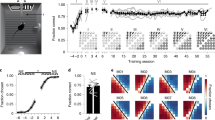Abstract
We examined attention shifting in baboons and humans during the learning of visual categories. Within a conditional matching-to-sample task, participants of the two species sequentially learned two two-feature categories which shared a common feature. Results showed that humans encoded both features of the initially learned category, but predominantly only the distinctive feature of the subsequently learned category. Although baboons initially encoded both features of the first category, they ultimately retained only the distinctive features of each category. Empirical data from the two species were analyzed with the 1996 ADIT connectionist model of Kruschke. ADIT fits the baboon data when the attentional shift rate is zero, and the human data when the attentional shift rate is not zero. These empirical and modeling results suggest species differences in learned attention to visual features.
Similar content being viewed by others
References
Anderson JR (1991) The adaptive nature of human categorization. Psychol Rev 98: 409–429
Cerella J (1979) Visual classes and natural categories in the pigeon. J Exp Psychol Hum Percept Perform 5: 68–77
D’Amato MR Sant P van 1988 The person concept in monkeys Cebus apella. J Exp Psychol Anim Behav Proc 1443-5
Dépy D, Fagot J, Vauclair J (1997) Categorisation of three-dimensional stimuli by humans and baboons: search for a prototype effect. Behav Proc 39: 299–306
Deruelle C, Fagot J (in press) Visual search for global/local stimulus features in humans and baboons. Psychonom Bull Rev
Fagot J, Deruelle C (1997) Processing of global and local visual information and hemispheric specialization in humans (Homo sapiens) and baboons (Papio papio). J Exp Psychol Hum Percept Perform 23: 429–442
Gluck MA, Bower GH (1988) From conditioning to category learning: an adaptive network model. J Exp Psychol Gen 117: 227–247
Goffe WL Ferrier GD Rogers J 1994 global optimizati of statistical functions with simulated annealing. J Ecometrics 6065-9
Kruschke JK (1992) ALCOVE: an exemplar-based connectionist model of category learning. Psychol Rev 99: 22–44
Kruschke JK (1996a) Base rates in category learning. J Exp Psychol Learning Mem Cogn 22: 3–26
Kruschke JK (1996b) Dimensional relevance shifts in category learning. Connection Sci 8: 201–223
Kruschke JK (1997) Attention in learning: relating Mackintosh’s (1975) theory to connectionist models and human categorization. Talk presented at the Eighth Australasian Mathematical Psychology Conference, Perth, Australia, 29 November 1997
Mackintosh NJ (1969) Comparative studies of reversal and probability learning: rats, birds and fish. In: Gilbert RM, Sutherland NS (eds) Animal discrimination learning. Academic Press, New York, pp 137–162
Mackintosh NJ (1975) A theory of attention: variations in the associability of stimuli with reinforcement. Psychol Rev 82: 276–298
Medin DL, Schaffer MM (1978) Context theory of classification learning. Psychol Rev 85: 207–238
Miller RR, Barnet RC, Grahame NJ (1995) Assessment of the Rescorla-Wagner model. Psychonom Bull 117: 363–389
Nosofsky RM (1986) Attention, similarity and the identification-categorization relationship. J Exp Psychol General 115: 39–57
Pearce JM (1994) Similarity and discrimination: a selective review and a connectionist model. Psychol Rev 101: 587–607
Rescorla RA, Wagner AR (1972) A theory of Pavlovian conditioning: variations in the effectiveness of reinforcement and non-reinforcement. In: Black AH, Prokosy WF (eds) Classical conditioning II. Current research and theory. Appleton-Century-Crofts, New York, pp 64–99
Shanks DR (1992) Connectionist accounts of the inverse base-rate effect in categorization. Connection Sci 4: 3-8
Siegel S, Allan LG (1996) The widespread influence of the Rescorla-Wagner model. Psychonom Bull Rev 3: 314–321
Sutherland NS, Mackintosh NJ (1971) Mechanisms of animal discrimination learning. Academic Press, New York
Vauclair J, Fagot J, Hopkins WD (1993) Rotation of mental images in baboons when the visual input is directed to the left cerebral hemisphere. Psychol Sci 4: 99–103
Wickens TD (1989) Multiway contingency tables analysis for the social sciences. Erlbaum, Hillsdale
Witte EA, Villareal M, Marroco RT (1996) Visual orienting and alerting in rhesus monkeys: comparison with humans. Behav Brain Res 82: 103–112
Author information
Authors and Affiliations
Rights and permissions
About this article
Cite this article
Fagot, J., Kruschke, J., Dépy, D. et al. Associative learning in baboons (Papio papio) and humans (Homo sapiens): species differences in learned attention to visual features. Anim Cogn 1, 123–133 (1998). https://doi.org/10.1007/s100710050017
Published:
Issue Date:
DOI: https://doi.org/10.1007/s100710050017




